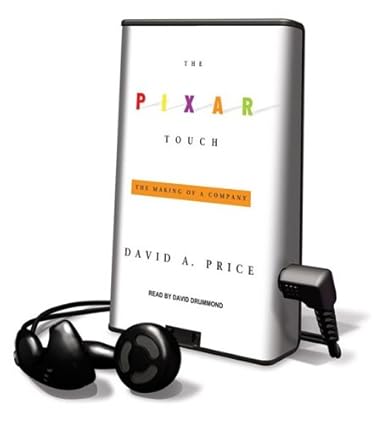
€62.53
The Pixar Touch by David A. Price Price comparison
The Pixar Touch by David A. Price Price History
The Pixar Touch by David A. Price Description
The Pixar Touch by David A. Price: An In-Depth Look
Discover the captivating journey of creativity and innovation with The Pixar Touch by David A. Price. This unabridged edition dives deep into the world of Pixar Animation Studios, revealing the artistic vision and relentless determination behind the creation of some of the most beloved animated films in history.
Key Features of The Pixar Touch
- Publisher: Tantor Media Inc
- Language: English
- ISBN-10: 1608125904
- ISBN-13: 978-1608125906
- Item Weight: 4.8 ounces
- Dimensions: 4.75 x 1.25 x 8 inches
Explore the Benefits of This Engaging Title
The Pixar Touch isn’t just a book; it’s a portal into the minds of some of the greatest storytellers and innovators of our time. Here are some features that make it a must-read:
- Comprehensive Narrative: This book chronicles the history of Pixar, providing a rich context for the studio’s journey from a small computer graphics company to a global powerhouse.
- Insider Insights: Gain a behind-the-scenes perspective on the challenges and triumphs faced during the production of legendary films like Toy Story and Finding Nemo.
- Inspiring Lessons: The Pixar Touch reveals how creativity thrives in collaboration, offering valuable lessons for creatives and entrepreneurs alike.
- Unabridged Format: This edition ensures you receive the full depth of David A. Price’s insights, making it perfect for those who want detailed information without missing a beat.
Price Comparison Across Suppliers
The price of The Pixar Touch by David A. Price varies across different retailers, making it crucial for consumers to compare options. Our price comparison feature displays current prices from various suppliers, ensuring you find the best deal. Notably, recent trends in the 6-month price history chart demonstrate stability, with occasional dips providing opportunities for those looking for a bargain. Be sure to monitor these fluctuations to make an informed purchase.
Customer Reviews and Feedback
Customer reviews on The Pixar Touch highlight its rich storytelling and insightful observations. Many readers appreciate the book’s engaging writing style, which makes complex industry insights accessible to all. Here’s a summary of the feedback:
- Positive Aspects: Readers commend its detailed exploration of Pixar’s unique culture and innovative processes. The narrative pulls you in, making it difficult to put the book down.
- Noted Drawbacks: Some reviews mention that while the book is fascinating, certain technical aspects might feel overwhelming for those unfamiliar with the animation industry.
Related Videos and Unboxings
To further enhance your understanding of The Pixar Touch by David A. Price, consider exploring related YouTube review and unboxing videos. These resources provide visual insights and can complement your reading experience. You’ll often find reviewers discussing their favorite parts and key takeaways from the book, providing additional context and enthusiasm for your purchase.
Conclusion
The Pixar Touch is not just a book but a treasure trove of creativity and inspiration, perfect for anyone interested in animation, storytelling, or the creative arts. By delving into its pages, you gain a deeper appreciation for the artistry behind some of your favorite films. Don’t miss out on the opportunity to explore this enlightening read. Compare prices now to find the best deal and take a step further into the magical world of Pixar!
The Pixar Touch by David A. Price Specification
Specification: The Pixar Touch by David A. Price
|
The Pixar Touch by David A. Price Reviews (8)
8 reviews for The Pixar Touch by David A. Price
Only logged in customers who have purchased this product may leave a review.


![Hercules & Xena: The Animated Movie [DVD]](https://discompare.eu/wp-content/uploads/thumbs_dir/hercules-xena-the-animated-movie-dvd-qsia6pgb29aklbgjx66g97l8e4gaag5l2o5wv14kxs.jpg)

![Pixar Short Films Collection Volume 2 [Blu-ray]](https://discompare.eu/wp-content/uploads/thumbs_dir/pixar-short-films-collection-volume-2-blu-ray-qymwith901uih2qfxfwvt999awwcyr25bmor1ylh4w.jpg)



sir joe M –
Il racconto di come Pixar è nata, cresciuta ed è diventata quello che oggi tutti conosciamo, nelle parole di tutti i protagonisti che in un momento o in un altro sono stati parte di questa realtà magica.
Un saggio giornalistico avvincente come un romanzo: si legge tutto d’un fiato
Robert Morris –
I re-read this book after reading the more recently published book co-authored by Bill Capodaglio and Lynn Jackson, Innovate the Pixar Way: Business Lessons from the World’s Most Creative Corporate Playground. (They also co-authored The Disney Way, Revised Edition: Harnessing the Management Secrets of Disney in Your Company.) Karen Paik is the author of another book, To Infinity and Beyond!: The Story of Pixar Animation Studios, that also provides a wealth of information about a unique organization and the brilliant people who have been centrally involved in it for more than 20 years.
Others have their reasons for thinking so highly of The Pixar Touch. First, David A. Price’s does a brilliant job of delineating the complicated chronological sequence that began with the hiring of Edwin Catmull (then at the New York Institute of Technology) to head the graphics group within the computer division at Lucasfilm (1979). Subsequently, Pixar Animation Studios (later shortened to Pixar) was purchased by Steve Jobs in 1986. After a highly successful IPO (11/29/1995), Years later, Jobs sold it to the Walt Disney Company for $7.4 billion (in an all-stock deal) in 2006. Price covers each of the company’s transitions thoroughly without bogging down in details. With the predictable exception of Jobs, those who provided leadership at Pixar demonstrate remarkable composure, indeed style and grace, during difficult times and sincere appreciation when lavished with praise, awards, and wealth. (Jobs’s primary – if not only – motive was and remains, the creation of “insanely great work.”) Price’s mini-biographies of the major figures probably provide the information that most people require.
Second, I was especially intrigued by the fact that the key people provide what Price characterizes as “unlikely ingredients” for success when they joined Pixar. John Lasseter was hired by Disney immediately after college and had just been fired. Catmull had been turned down for a teaching position and “ended up in what he felt was a dead-end software development job” at Computer Graphics Lab. Alvy Ray Smith was employed by Xerox’s Palo Alto Research Center (PARC) “and then abruptly found himself out on the street.” As for Jobs, he had been forced from the company he co-founded, was widely ridiculed, and considered a has-been. Price suggests that, despite and perhaps because of these and other serious setbacks, those who established and developed Pixar illustrate Joseph Schumpeter’s observation that successful innovation “is a feat not of intellect, but of will.”
Finally, I admire Price’s skills when explaining the artistic significance of each of the feature films that Pixar has produced from Toy Story (1996) until WALL-E (2009). He establishes a multi-dimensional context for each, identifying the challenges the production process faced and eventually overcame. With regard to the creative process, for example, the original attributes of the two central characters in Toy Story (Woody and Buzz Lightyear) underwent significant changes as did the initial thoughts about the relationship between them. Those involved in collaboration at Pixar have always followed John Lasseter’s admonition that “quality is the best business plan” and embraced Ed Catmull’s assertion that perfection is a minimum standard. Production of each of the other feature films also demonstrates the same commitment to artistic standards that few other films achieve.
Leaders in any organization can read and re-read this book, then attempt to apply the business principles and core values that define what Pixar does and how it does it. Although the principles and values are sound, however, they are insufficient. What is also needed is the Pixar “touch” and there is no way that David Price or anyone else can explain how to develop it but you’ll know it when you see it…in any of the Pixar films.
Mattias Fahlin –
I bought the book thinking it would give a background to the “Pixar’s 22 rules of storytelling”. In hindsight I didn’t pay attention to the title of the Book. 😉
I got a completely different story, Pixar’s backstory. All in all a good book.
M. Strong –
For the vast majority of us, Pixar became an overnight success with the theatrical release of Toy Story. Like so many other overnight successes, Pixar’s history is actually much longer and much more fraught with difficulties than many of us will ever know… unless we read Price’s book.
David Price does a wonderful job telling the story of the group of people who came together over a period of 15 years to become Pixar. While this is a business book, Price adopts something of the story-telling and fun that is inherent to Pixar itself and makes it part of his book, too. That makes this a great story not just for business people, but also for those who are simply fans of Pixar’s movies and would like to know more about how they came to be.
The stories are fascinating. I never knew that Pixar was once owned by George Lucas as part of Industrial Light and Magic, but that Lucas – of all people – couldn’t see computers being used to make feature films. It’s great to hear how the stories of the different Pixar films developed, how the technology developed and how the business finally paid off in spades after years and years of losing money.
I highly recommend this book for fans of business, fans of technology and even for anyone who’s just a fan of the Pixar films. You won’t be disappointed.
Client d’Amazon –
Un très bon ouvrage qui propose une histoire du studio d’animation Pixar, depuis ses prémices chez Lucasfilm, jusqu’à ses derniers succès vers 2008. Je le recommande à tous ceux qui aimeraient connaitre la vie de ce magnifique studio.
Bas Vodde –
The Pixar Touch is the story about the road to success for the Pixar company. It is well written, funny at times and I enjoyed reading it — especially the first half. During the second half, I got slightly bored by the book, but would still recommend everyone who has an interest in Pixar, animation and movies to read this book.
I felt the book consisted of 2 major parts (not explicitly set like that in the book). The first part (chapter 1-5) describes the struggles that Pixar went through before they were able to work on their first animation movie (Toy Story). How a group of passionate computer graphics experts stayed together while being moved from one company to another company and how they eventually end up with Steve Jobs. Then, most interestingly, how Steve Jobs tried to get rid of Pixar but failed to do so. I liked this part of the book most (by far).
The second part of the book consists of the pixar movies and the struggles with Disney. The authors goes over all the movies and gives some description of the movie and dives in the history. Sums up how the movie was received and what impact that had on the Disney relationship. This part of the book was, in my opinion, less interesting and sometimes even a little boring.
All in all, I enjoyed the book a lot and learned how Pixar fits in the history of computing and graphics. Its well written, well researched and definitively worth reading. Recommended.
ANAND BHABHOR –
Good
Azam Mohammed –
A very interesting book on the up and coming of Pixar, it outlines all the struggles and details surrounding management, production, releases, conversations, controversies which all lead up to the point of their full fledged movies. This initially caught my eye after reading a glimpse about Pixar in Steve Job’s biography. For those that have read Steve Jobs biography, this book serves as a good ‘part 2’. The book was really interesting (it runs through a lot of the technical aspects of early movie production throughout the book), while not being tedious or throwing too much technical jargon at the non-technical readers, a very fitting book overall.